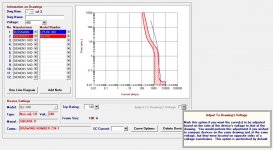Grouch
Senior Member
- Location
- New York, NY
Hi all,
I put together this graph just as an example; this is from the 'E-Coord' program by Elite Software. I'm trying to do a coordination analysis between 2 devices. The 300 amp Bussmann fuses (shown in blue) are on the primary of a transformer (@480v), and the 100 amp Square D circuit breaker (in red) is on the secondary of the transformer (@208v).
The 'drawing voltage' is 480 volts as you see on the top left, which is the transformer primary. This would be the base / overall voltage of the graph.
I have to click on 'adjust to drawing's voltage' on the bottom right for the secondary fuses, where you see the instruction tab next to it. The secondary voltage would be 208 volts as I mentioned above. The red graph for the breaker would shift to the left to accommodate the adjustment for 480 volts.
My question is: if anybody is familiar with this program (or maybe it's similar to EasyPower as well)... when I click on 'adjust to drawing's voltage'... how does the program know that my voltage on the secondary is 208 volts? How do these programs know, whether E-Coord or EasyPower, the transformer ratio?
If you look on the lower left, you'll see 240 volts... but that's the voltage rating of the breaker, it's not the 208 volts on the output of the transformer secondary. I'm assuming, based on the instruction tab on the lower right... I have to adjust the voltage rating of the breaker down to 208 volts?

I put together this graph just as an example; this is from the 'E-Coord' program by Elite Software. I'm trying to do a coordination analysis between 2 devices. The 300 amp Bussmann fuses (shown in blue) are on the primary of a transformer (@480v), and the 100 amp Square D circuit breaker (in red) is on the secondary of the transformer (@208v).
The 'drawing voltage' is 480 volts as you see on the top left, which is the transformer primary. This would be the base / overall voltage of the graph.
I have to click on 'adjust to drawing's voltage' on the bottom right for the secondary fuses, where you see the instruction tab next to it. The secondary voltage would be 208 volts as I mentioned above. The red graph for the breaker would shift to the left to accommodate the adjustment for 480 volts.
My question is: if anybody is familiar with this program (or maybe it's similar to EasyPower as well)... when I click on 'adjust to drawing's voltage'... how does the program know that my voltage on the secondary is 208 volts? How do these programs know, whether E-Coord or EasyPower, the transformer ratio?
If you look on the lower left, you'll see 240 volts... but that's the voltage rating of the breaker, it's not the 208 volts on the output of the transformer secondary. I'm assuming, based on the instruction tab on the lower right... I have to adjust the voltage rating of the breaker down to 208 volts?



